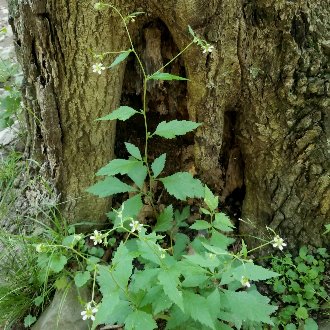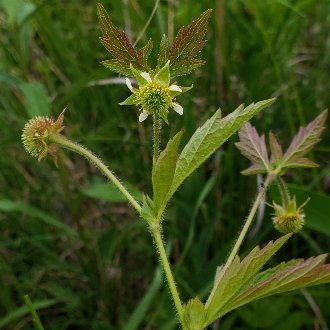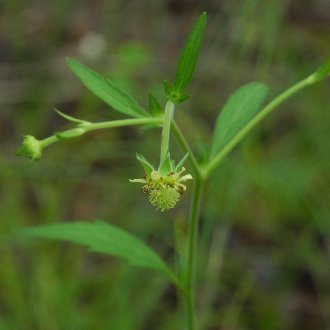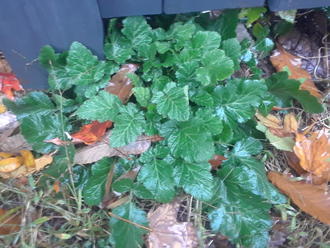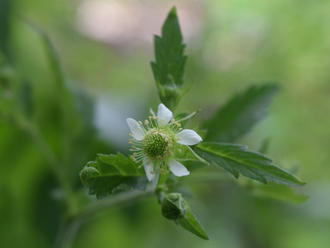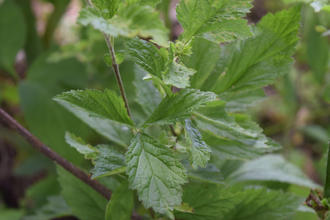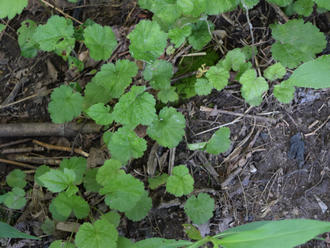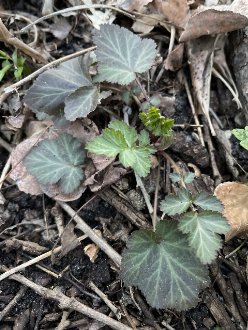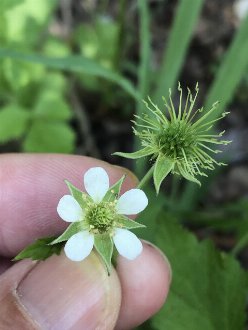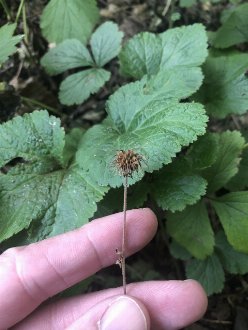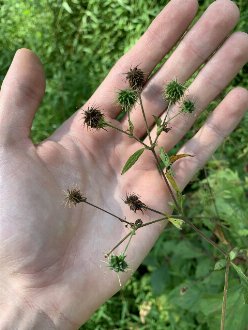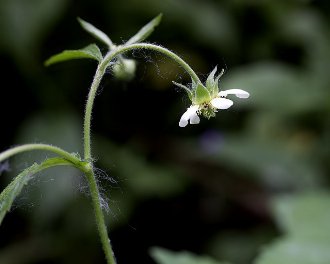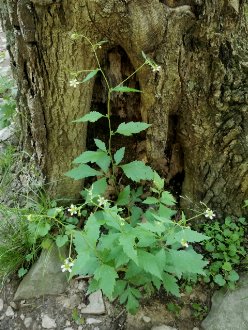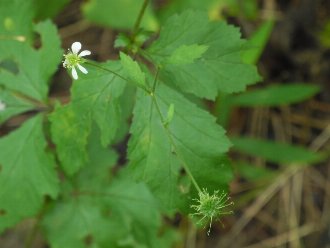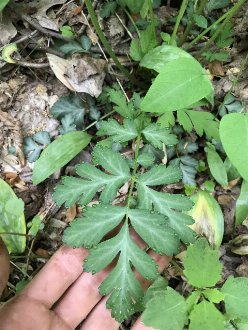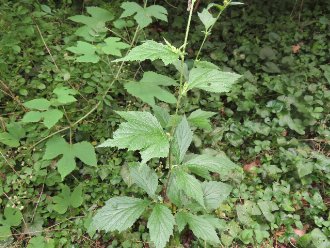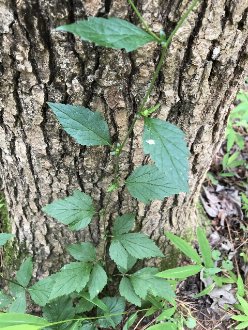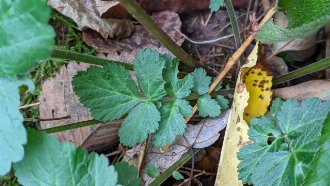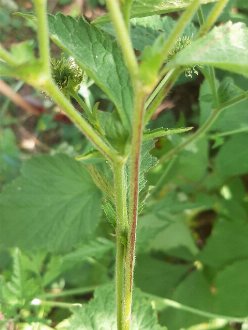White Avens (Geum canadense Jacq.)
↑Summary
An perennial with inconspicuous flowers native and common across much of central to eastern North America.
↑Range - Expand
| Legend | Color |
| Native | |
| Native or Not Present |
This tentative map is based on our own research. It may have limited data on Canada and/or Mexico, and there is some subjectivity in our assignment of plants as introduced vs. expanded. Read more in this blog post.
Although this plant occurs somewhere in each of these regions, it may only occur in a small part of some or all of them.
This species is also native to both Canada and Mexico, but we have yet to build these portions of its range map.
↑Description & Identification
This species poses an ID challenge to casual plant enthusiasts as it looks wildly different at different times of year, and it also superficially resembles not only numerous other Geum species, but a number of other less-closely-related plants.
It is important to learn to recognize how this plant's appearance changes throughout the growing season. The flowers are only available for a short period of time, but the basal rosettes and seedheads are often more persistent.
↑Similar Plants
↑Habitat
White avens is found in a wide range of disturbed, partly-shaded habitats in eastern to central North America. It is fairly generalist and found in a wide range of conditions.
It is most common in forest edges, thickets, and open deciduous woodlands. It also grows less commonly in meadows or tallgrass prairies, and closed-canopy mesic deciduous forests. It is frequent in anthropogenic habitats including small forest fragments, shaded areas along roads and railroads, and overgrown areas and small semi-wild areas in urban and suburban areas.
White avens prefers loam to clay-loam soils, but tolerates a wide range of soil conditions including ones with some clay or gravel, and may prefer soils of slightly lower fertility, such as areas where some topsoil has been eroded, or areas of patchy soil fertility where it can establish on a fertile site and the foliage can sprawl over less fertile ground.
It is found in a range of moisture conditions from most to slightly dry, tolerating greater sun in moister habitats. It is more common in bottomlands; in upland habitats it usually occurs on locally-moist sites such as small depressions. It prefers disturbed habitats, and may be favored in habitats overbrowsed by deer.
↑Life Cycle
Seedlings establish a taproot and a basal rosette of leaves. Different sources report different root structures, ranging from a taproot, to multiple taproots, to rhizomes, to fibrous roots largely at the surface; the root system likely takes on a different structure on different sites.
Does not usually flower in its first year.
The basal rosette is evergreen or semi-evergreen in warmer climates and warmer winters, sometimes even in cold winters if covered by snow. Basal leaves on larger rosettes benefit from the protection of a light layer of leaf litter, and the leaf structure may help trap leaves which later break down and enrich the soil around the base of a plants on areas with more eroded soil. New growth begins in early spring, but remains close to the ground until temperatures warm.
Already established plants bolt during the warmer season, and the leaf shape and structure changes considerably, to thinner, more delicate, simpler leaves. Plants bloom mid-summer, and blooms are followed by fruits, which are a cluster of seeds with hooks that allow them to attach to clothing or animal fir. Seeds may remain on the plant for a long time, often into or through winter, leading the timing of seedfall to vary widely from one individual seed to the next.
Seeds contain adaptations to change germination requirement as a function of dispersal time. Seeds distributed in late summer (September or slightly later) can germinate immediately, but seeds distributed later remain dormant through winter and germinate in spring. Seeds distributed early in spring germinate immediately; seeds distributed later (May and June) as temperatures are warmer will remain dormant until the subsequent spring so that seedlings are not killed by drought. Regardless of dispersal time, germination is triggered by light, thus leading this species only to establish on sites where disturbance has removed some vegetation.
Plants sometimes reproduce vegetatively by rhizomes, forming small clonal colonies, although most plants do not spread in this way. Unlike some rhizomatous plants, this behavior does not necessarily occur on the richest sites; we could not find information on what triggers this behavior.
Plants can spread both by rhizomes or seeds into lawns and mowed areas, where the basal rosette can survive mowing, but is not able to reproduce in regularly mowed areas.
We could not find information on this species lifespan, or typical causes of mortality. It can be eliminated from closed canopy deciduous forests in the absence of disturbance as overhead shade becomes too heavy, and plants can also be killed by prolonged flooding, but individuals likely persist for many years on suitable sites.
↑Faunal Associations
The foliage has low palatability to mammals, and is only infrequently browsed by deer.
The inconspicuous flowers attract a variety of insects, including various bees and syrphid flies, which feed on both pollen and nectar, and wasps and beetles which mostly only collect nectar. The sap is eaten by a large number of different aphid species, including Amphorophora rossi, which prefers this species, and others including Acyrthosiphon pseudodirhodum, and Macrosiphum gei which feeds on the upper parts of the flower stem, Macrosiphum pallidum which mostly feeds on a variety of plants of the Rosaceae family, and the rose aphid (Macrosiphon pseudorosae) which prefers roses but also eats a variety of other plants. The leaf-miner moth Tinagma obscurofasciella eats this and other related plants including other Geum and Potentilla species. Several other moths have been recorded eating other Geum species but we could not find any documentation of other species found to eat this one specifically.
The seeds stick to animal fur, clothing, and to a lesser degree, bird feathers, and can be distributed to new sites by this mechanism.
↑Uses
Uncommonly used as a garden or landscaping plant, where is it valued for its attractive winter foliage and ability to grow well in areas where other plants will not. Often viewed as weedy in gardens.
↑Related Plants
Numerous other Geum species co-occur in much of this species range, although there are also parts of its range where it is the only member of its genus. We could not find any information on the relationships within this genus.
This species does hybridize readily with the introduced herb bennet (Geum urbanum) to form Geum ×catlingii, which could be an indicator of a close relationship, whereas it does not hybridize readily with any of the native species. However, hybridization is not necessarily an indicator of a closer relationship: it may reflect minor changes that result in reproductive isolation, such as polyploidy or changes in bloom time. Native Geum tend to have the same chromosome count 2N=42) but are often separated in terms of bloom time.
Within the Rosaceae (rose) family, Geum is usually placed in the Colurieae tribe, which, in North America, only contains one other species, apache plume (Fallugia paradoxa), which is native to the southwest, and only overlaps with this species in a tiny region of Oklahoma.
More broadly this tribe belongs to the Rosoideae subfamily, which includes numerous species, both native and introduced.
↑Links & External Resources
• Geum canadense (White Avens) | Illinois Wildflowers (About This Site)
• Geum canadense (White Avens) | USDA PLANTS Database (About This Site)
• Geum canadense | Go Botany (About This Site)
• Geum canadense | Biota of North America Project (BONAP) (About This Site)
• Geum canadense | NatureServe Explorer (About This Site)
• Geum canadense | Flora of North America (About This Site)
• Geum canadense | Missouri Plants (About This Site)
• White Avens | Maryland Biodiversity Project (About This Site)
• Geum canadense (White Avens) | Minnesota Wildflowers (About This Site)
• Geum canadense Jacquin (White Avens) | Digital Atlas of the Virginia Flora (About This Site)



